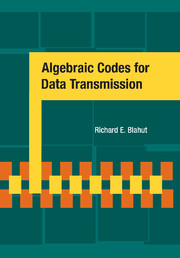Book contents
- Frontmatter
- Contents
- Preface
- Dedication
- 1 Introduction
- 2 Introduction to Algebra
- 3 Linear Block Codes
- 4 The Arithmetic of Galois Fields
- 5 Cyclic Codes
- 6 Codes Based on the Fourier Transform
- 7 Algorithms Based on the Fourier Transform
- 8 Implementation
- 9 Convolutional Codes
- 10 Beyond BCH Codes
- 11 Codes and Algorithms Based on Graphs
- 12 Performance of Error-Control Codes
- 13 Codes and Algorithms for Majority Decoding
- Bibliography
- Index
4 - The Arithmetic of Galois Fields
Published online by Cambridge University Press: 05 June 2012
- Frontmatter
- Contents
- Preface
- Dedication
- 1 Introduction
- 2 Introduction to Algebra
- 3 Linear Block Codes
- 4 The Arithmetic of Galois Fields
- 5 Cyclic Codes
- 6 Codes Based on the Fourier Transform
- 7 Algorithms Based on the Fourier Transform
- 8 Implementation
- 9 Convolutional Codes
- 10 Beyond BCH Codes
- 11 Codes and Algorithms Based on Graphs
- 12 Performance of Error-Control Codes
- 13 Codes and Algorithms for Majority Decoding
- Bibliography
- Index
Summary
The most powerful and important ideas of coding theory are based on the arithmetic systems of Galois fields. Since these arithmetic systems may be unfamiliar to many, we must develop a background in this branch of mathematics before we can proceed with the study of coding theory.
In this chapter, we return to the development of the structure of Galois fields begun in Chapter 2. There we introduced the definition of a field, but did not develop procedures for actually constructing Galois fields in terms of their addition and multiplication tables. In this chapter, we shall develop such procedures. Galois fields will be studied by means of two constructions: one based on the integer ring and one based on polynomial rings. Because the integer ring and the polynomial rings have many properties in common we will find that the two constructions are very similar. Later, after the constructions of Galois fields are studied, we shall prove that all finite fields can be constructed in this way.
The integer ring
The set of integers (positive, negative, and zero) forms a ring under the usual operations of addition and multiplication. This ring is conventionally denoted by the label Z. We shall study the structure of the integer ring in this section.
- Type
- Chapter
- Information
- Algebraic Codes for Data Transmission , pp. 67 - 95Publisher: Cambridge University PressPrint publication year: 2003



